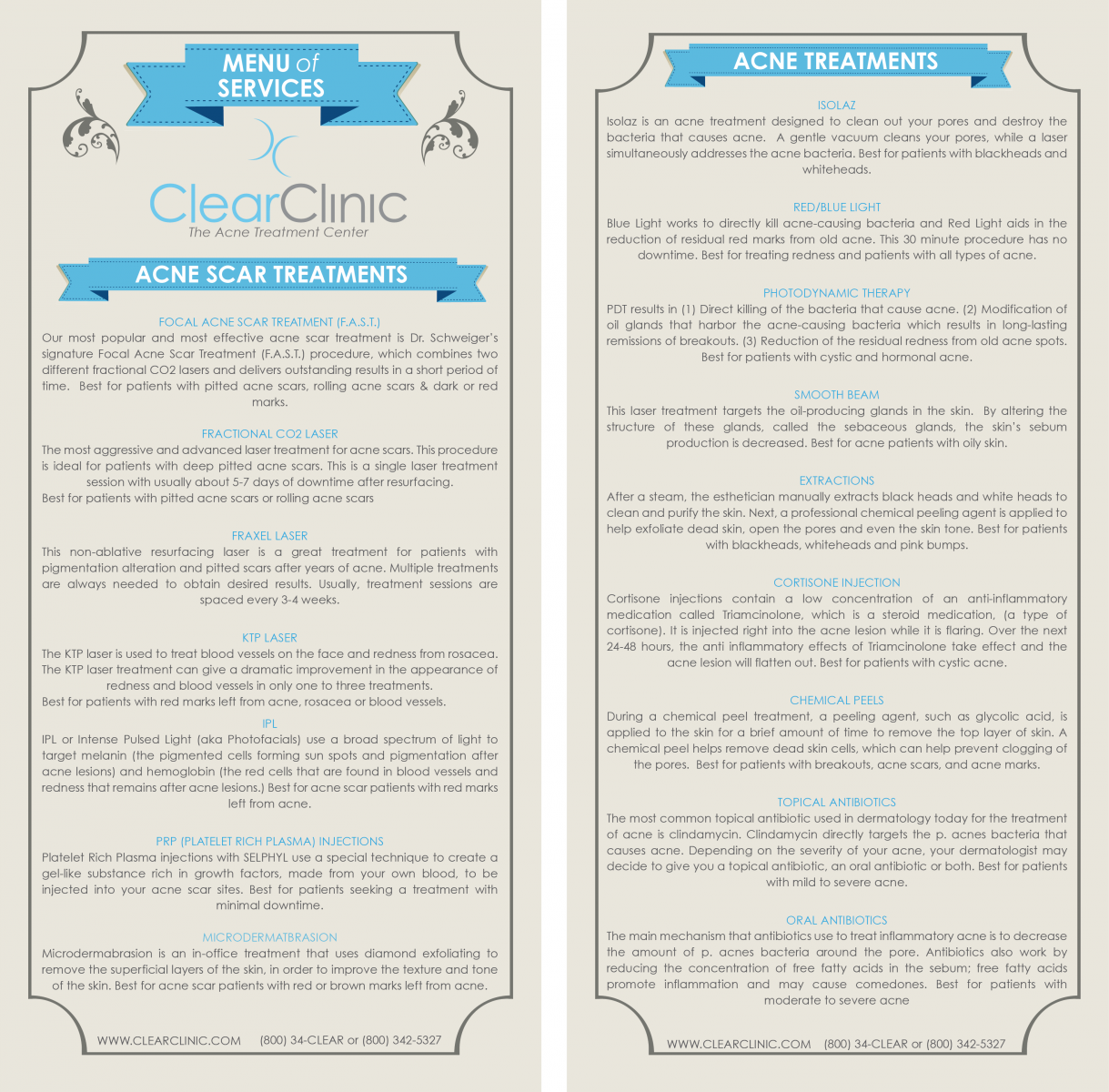 Pimples No More
Pimples No More
When you have acne-prone skin, it can feel like a daily battle when trying to get rid of pimples. Those that suffer from acne sometimes make mistakes when it comes to daily skin care and anti-acne treatments. When you want clear, blemish-free skin, there are some simple rules to follow and some professional treatments that will help do the job.
A Healthy Diet May Eliminate Pimples
It sounds confusing, but what you eat may actually play a role in whether or not you develop zits. The thinking that food plays a role in acne breakouts was chalked up as a myth, but new research in this area is actually showing some evidence that is to the contrary. A high-glycemic diet, which means complex carbohydrates and sugary foods, may in fact lead to acne breakouts. Foods that rate high on the glycemic scale, which includes white bread, white rice, candy bars, cakes, cookies and donuts, may increase the insulin in your body and cause hormones to surge, leading to inflammation and pimples. So if you want to get rid of acne, be on the safe side and stick to a diet filled with whole grains, protein, and leafy greens.
Pimple Myths Debunked
Have you ever heard of someone putting toothpaste on their zit? It’s one of the most common acne myths, right up there with sun exposure being beneficial in clearing up acne. It’s important to know what’s the truth and what’s false when it comes to clearing up your skin. Many patients believe that their acne is improved when they have a suntan, so it is difficult for them to understand when we tell them the real answer that a suntan will not help your acne in the long term. While a tan may temporarily camouflage discoloration from old acne breakouts and can sometimes dry up excess oil on the skin, these effects are only temporary and the risk of direct sun exposure outweighs the benefits of a temporary suntan. For patients who think their skin gets clearer in the summer, an in-office or at home blue light therapy may be a great choice. Toothpaste, while it’s great at fighting cavities, is not so great at fighting pimples. In fact, toothpaste contains many ingredients that might worsen your acne. The best spot treatments to use on active acne breakouts are products containing salicylic acid or sulfur.
Adult Acne Versus Teenage Pimples
While the same causative agents that lead to acne formation form both adult acne and teenage acne, the treatment plans can differ greatly. Teens with acne tend to have oilier skin overall, whereas adult skin is typically drier. For that reason, it is best to avoid treating pimples with high percentages of benzoyl peroxide or salicylic acid. Adult acne sufferers do well with retinoids, as they fight acne and wrinkles at the same time. Teenage acne sufferers can tolerate prescription medications better and will sometimes go on Accutane.
Hiding Pimples with Makeup
You may be tempted to cake on the concealer when trying to cover up an acne lesion, but less is more when it concealing a pimple. The first order of business is covering up any redness by gently dabbing concealer over the red area, being careful not to cover the raised area. You will want to use a clean finger to gently press the concealer into the pimple. Do not use a brush or sponge, as this will only wipe off the concealer. The next step is lightly pressing on powder to set the concealer. Using makeup to conceal and get rid of pimples—or at least their appearance—will help you feel better about yourself.
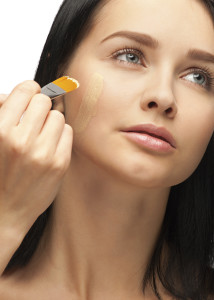 Many women can’t leave the house without it. And we spend hours and hours of our lives reading about it, applying it and buying it. We’re talking about makeup. And there’s a reason it is a billion dollar business. But if you have acne-prone skin, navigating the tricky world of color cosmetics and deciding what to wear on your skin can be very confusing and can even be detrimental if you don’t know what to look for–and what to avoid.
Many women can’t leave the house without it. And we spend hours and hours of our lives reading about it, applying it and buying it. We’re talking about makeup. And there’s a reason it is a billion dollar business. But if you have acne-prone skin, navigating the tricky world of color cosmetics and deciding what to wear on your skin can be very confusing and can even be detrimental if you don’t know what to look for–and what to avoid.

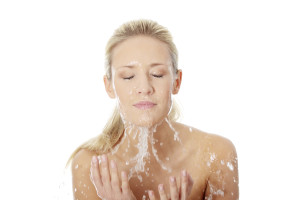
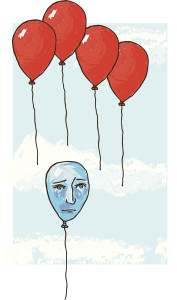
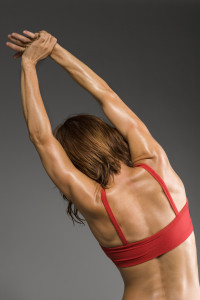
 Pimples No More
Pimples No More Savvy New Yorkers have no qualms in turning to the experts for help in all things related to health, beauty and fashion. With the best of the best at our fingertips, New York City residents have the advantage of top experts to aid them in everything from fitness to fashion, such as personal trainers and personal shoppers. Thanks to Clear Clinic, New Yorkers now have acne experts to turn to when their skin is not behaving. Enter the Personal Acne Coach, skincare specialists devoted to the clearing and healing of the skin from acne breakouts and acne scarring. Our Personal Acne Coaches are like trainers for your skin, helping you get on the right regimen and treatment plan to get your skin clear and gorgeous. Our Personal Acne Coaches will help explain each and every treatment and procedure offered at Clear Clinic and whether it’s right for your skin type and lifestyle. They are also on hand to answer any questions along the way. Some of our top acne treatments include photodynamic therapy, signature medical facials, and cortisone injections. We recommend in-office procedures in combination with at-home care as the ideal prescription for clear skin. One of the main goals of in-office procedures such as cortisone injections and medical extractions is to prevent acne sufferers from picking and popping their acne. We refer to this as “bathroom surgery” and it can be incredibly harmful to the skin. In fact, when you try and pop a pimple, the majority of the bacteria re-enters the skin, with only a very small percentage of it coming out. If you are serious about healing your skin and saying goodbye to pimples forever, then it’s crucial to seek out the best acne treatments in NYC.
Savvy New Yorkers have no qualms in turning to the experts for help in all things related to health, beauty and fashion. With the best of the best at our fingertips, New York City residents have the advantage of top experts to aid them in everything from fitness to fashion, such as personal trainers and personal shoppers. Thanks to Clear Clinic, New Yorkers now have acne experts to turn to when their skin is not behaving. Enter the Personal Acne Coach, skincare specialists devoted to the clearing and healing of the skin from acne breakouts and acne scarring. Our Personal Acne Coaches are like trainers for your skin, helping you get on the right regimen and treatment plan to get your skin clear and gorgeous. Our Personal Acne Coaches will help explain each and every treatment and procedure offered at Clear Clinic and whether it’s right for your skin type and lifestyle. They are also on hand to answer any questions along the way. Some of our top acne treatments include photodynamic therapy, signature medical facials, and cortisone injections. We recommend in-office procedures in combination with at-home care as the ideal prescription for clear skin. One of the main goals of in-office procedures such as cortisone injections and medical extractions is to prevent acne sufferers from picking and popping their acne. We refer to this as “bathroom surgery” and it can be incredibly harmful to the skin. In fact, when you try and pop a pimple, the majority of the bacteria re-enters the skin, with only a very small percentage of it coming out. If you are serious about healing your skin and saying goodbye to pimples forever, then it’s crucial to seek out the best acne treatments in NYC.